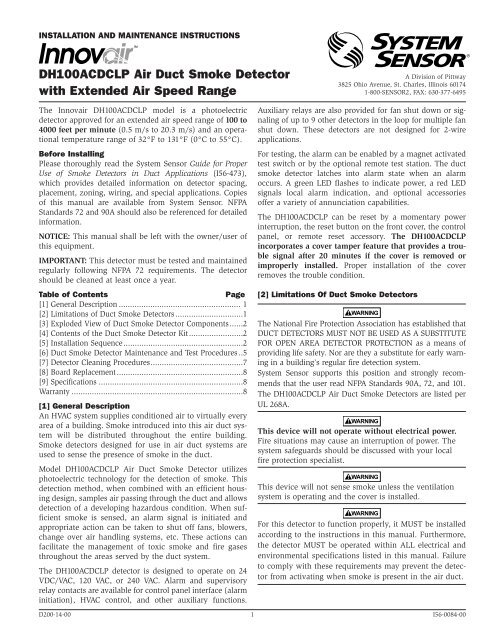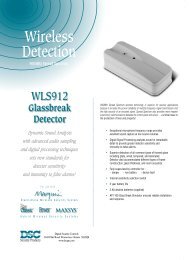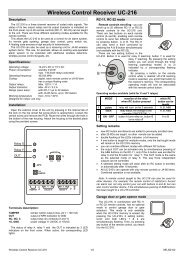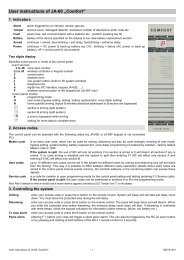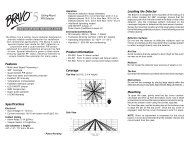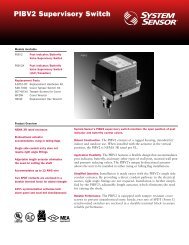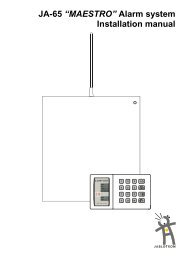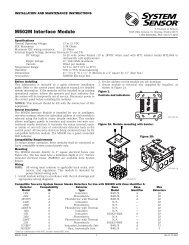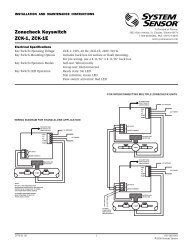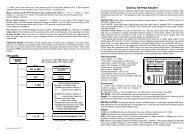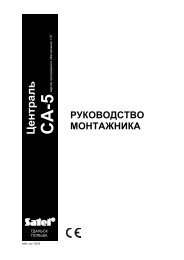DH100ACDCLP Air Duct Smoke Detector with Extended Air Speed ...
DH100ACDCLP Air Duct Smoke Detector with Extended Air Speed ...
DH100ACDCLP Air Duct Smoke Detector with Extended Air Speed ...
- No tags were found...
Create successful ePaper yourself
Turn your PDF publications into a flip-book with our unique Google optimized e-Paper software.
INSTALLATION AND MAINTENANCE INSTRUCTIONS<strong>DH100ACDCLP</strong> <strong>Air</strong> <strong>Duct</strong> <strong>Smoke</strong> <strong>Detector</strong><strong>with</strong> <strong>Extended</strong> <strong>Air</strong> <strong>Speed</strong> RangeA Division of Pittway3825 Ohio Avenue, St. Charles, Illinois 601741-800-SENSOR2, FAX: 630-377-6495The Innovair <strong>DH100ACDCLP</strong> model is a photoelectricdetector approved for an extended air speed range of 100 to4000 feet per minute (0.5 m/s to 20.3 m/s) and an operationaltemperature range of 32°F to 131°F (0°C to 55°C).Before InstallingPlease thoroughly read the System Sensor Guide for ProperUse of <strong>Smoke</strong> <strong>Detector</strong>s in <strong>Duct</strong> Applications (I56-473),which provides detailed information on detector spacing,placement, zoning, wiring, and special applications. Copiesof this manual are available from System Sensor. NFPAStandards 72 and 90A should also be referenced for detailedinformation.NOTICE: This manual shall be left <strong>with</strong> the owner/user ofthis equipment.IMPORTANT: This detector must be tested and maintainedregularly following NFPA 72 requirements. The detectorshould be cleaned at least once a year.Table of ContentsPage[1] General Description ...................................................... 1[2] Limitations of <strong>Duct</strong> <strong>Smoke</strong> <strong>Detector</strong>s ..............................1[3] Exploded View of <strong>Duct</strong> <strong>Smoke</strong> <strong>Detector</strong> Components......2[4] Contents of the <strong>Duct</strong> <strong>Smoke</strong> <strong>Detector</strong> Kit........................2[5] Installation Sequence .....................................................2[6] <strong>Duct</strong> <strong>Smoke</strong> <strong>Detector</strong> Maintenance and Test Procedures ..5[7] <strong>Detector</strong> Cleaning Procedures.........................................7[8] Board Replacement........................................................8[9] Specifications ................................................................8Warranty ............................................................................8[1] General DescriptionAn HVAC system supplies conditioned air to virtually everyarea of a building. <strong>Smoke</strong> introduced into this air duct systemwill be distributed throughout the entire building.<strong>Smoke</strong> detectors designed for use in air duct systems areused to sense the presence of smoke in the duct.Model <strong>DH100ACDCLP</strong> <strong>Air</strong> <strong>Duct</strong> <strong>Smoke</strong> <strong>Detector</strong> utilizesphotoelectric technology for the detection of smoke. Thisdetection method, when combined <strong>with</strong> an efficient housingdesign, samples air passing through the duct and allowsdetection of a developing hazardous condition. When sufficientsmoke is sensed, an alarm signal is initiated andappropriate action can be taken to shut off fans, blowers,change over air handling systems, etc. These actions canfacilitate the management of toxic smoke and fire gasesthroughout the areas served by the duct system.The <strong>DH100ACDCLP</strong> detector is designed to operate on 24VDC/VAC, 120 VAC, or 240 VAC. Alarm and supervisoryrelay contacts are available for control panel interface (alarminitiation), HVAC control, and other auxiliary functions.Auxiliary relays are also provided for fan shut down or signalingof up to 9 other detectors in the loop for multiple fanshut down. These detectors are not designed for 2-wireapplications.For testing, the alarm can be enabled by a magnet activatedtest switch or by the optional remote test station. The ductsmoke detector latches into alarm state when an alarmoccurs. A green LED flashes to indicate power, a red LEDsignals local alarm indication, and optional accessoriesoffer a variety of annunciation capabilities.The <strong>DH100ACDCLP</strong> can be reset by a momentary powerinterruption, the reset button on the front cover, the controlpanel, or remote reset accessory. The <strong>DH100ACDCLP</strong>incorporates a cover tamper feature that provides a troublesignal after 20 minutes if the cover is removed orimproperly installed. Proper installation of the coverremoves the trouble condition.[2] Limitations Of <strong>Duct</strong> <strong>Smoke</strong> <strong>Detector</strong>sWARNINGThe National Fire Protection Association has established thatDUCT DETECTORS MUST NOT BE USED AS A SUBSTITUTEFOR OPEN AREA DETECTOR PROTECTION as a means ofproviding life safety. Nor are they a substitute for early warningin a building’s regular fire detection system.System Sensor supports this position and strongly recommendsthat the user read NFPA Standards 90A, 72, and 101.The <strong>DH100ACDCLP</strong> <strong>Air</strong> <strong>Duct</strong> <strong>Smoke</strong> <strong>Detector</strong>s are listed perUL 268A.WARNINGThis device will not operate <strong>with</strong>out electrical power.Fire situations may cause an interruption of power. Thesystem safeguards should be discussed <strong>with</strong> your localfire protection specialist.WARNINGThis device will not sense smoke unless the ventilationsystem is operating and the cover is installed.WARNINGFor this detector to function properly, it MUST be installedaccording to the instructions in this manual. Furthermore,the detector MUST be operated <strong>with</strong>in ALL electrical andenvironmental specifications listed in this manual. Failureto comply <strong>with</strong> these requirements may prevent the detectorfrom activating when smoke is present in the air duct.D200-14-00 1 I56-0084-00
[3] Figure 1: Exploded View Of <strong>Duct</strong> <strong>Smoke</strong> <strong>Detector</strong> ComponentsFOAMGASKETSSAMPLING TUBEFILTERSCONDUIT HOLESDETECTORHOUSINGPLASTICSAMPLING TUBETERMINAL STRIPPOWER BOARDPLASTIC SAMPLING TUBESELF-TAPPING SCREWCOVER MOUNTINGSCREWSDETECTOR BOARDDETECTORCOVER[4] Contents Of The <strong>Duct</strong> <strong>Smoke</strong> <strong>Detector</strong> Kit1. Complete housing base and cover assembly2. Two #10 machine screws for mounting3. Two sampling tube filters4. One test magnet5. Drilling template6. Two foam gaskets7. Four #6-self tapping mounting screws for the metalsampling tube and optional exhaust tube extension8. Two jack nuts9. One inlet tube end plug10. One plastic sampling tube11. One #8 self-tapping screw for the plastic sampling tubeNOTE: For ducts over 1 1 ⁄2 feet, longer inlet sampling tubesmust be ordered to complete the installation. Theymust be the correct length for the width of the ductwhere they will be installed. See Table 1 on page 3to determine the inlet tube required for differentduct widths.[5] Installation Sequence[5.1] Verify <strong>Duct</strong> <strong>Air</strong> Flow Direction And VelocityModel <strong>DH100ACDCLP</strong> detectors are designed to be used inair handling systems having air velocities of 100 to 4000feet per minute. Be sure to check engineering specificationsto ensure that the air velocity in the duct falls <strong>with</strong>in theseparameters. If necessary, use a velocity meter (anemometer)to check the air velocity in the duct.[5.2] Drill The Mounting HolesRemove the paper backing from the mounting templatesupplied. Affix the template to the duct at the desiredmounting location. Make sure the template lies flat andsmooth on the duct. Center punch holes A and B. Drill theholes as indicated on the template. Insert the two jack nutreceptacles. Drive a #10 machine screw into jacket to flarethe retainer, then back out the screw to use for detectormounting.[5.2.1] Sampling Tube Installation for <strong>Duct</strong>s LessThan 1 1 ⁄2 Feet Wide (see Figure 2)1. Remove the front cover.2. Slide the plastic sampling tube into the housing bushing.3. Align the holes in the bushing <strong>with</strong> the holes in the samplingtube. Make sure there are 6 exposed holes on theplastic sampling tube. Secure <strong>with</strong> the #8 self-tappingscrew into the bottom of the permanent tube (shown inFig. 2).NOTE: For ducts greater than 1 1 ⁄2 feet in width, refer tosections [5.4.1] and [5.4.2].Figure 2. Plastic sampling tube connected to ductsmoke detector:[5.3] Secure The <strong>Detector</strong> Housing To The <strong>Duct</strong>Slide the foam gaskets over the tube bushings as shown inFigure 3. Use the two machine screws to screw the detectorhousing to the duct.CAUTION: Do not overtighten the screws.D200-14-00 2 I56-0084-00
Figure 3. Installation of foam gaskets over samplingtube bushings:SCREW HOLES FORATTACHING HOUSINGTO DUCT WORK.A78-2045-00[5.4] Sampling Tube Installation for <strong>Duct</strong>s GreaterThan 1 1 ⁄2 Feet WideThe sampling tube is identified by a series of air inlet holeson the tube. A plastic tube is included for ducts up to 18″in width. All other lengths must be purchased separately.Order the correct length, as specified in Table 1, for widthof the duct where it will be installed. The exhaust tube ismolded onto the base of the duct housing, and theA2440-00 Exhaust Tube Extension is available as an accessoryin those cases where the molded exhaust port does notextend at least 2 inches into the duct.The inlet tube is always installed <strong>with</strong> the air inlet holesfacing into the air flow. To assist proper installation, thetube’s mounting flange is marked <strong>with</strong> arrows. Make surethe inlet tube is mounted so that the arrows point into theair flow (see Figure 4). Figure 5 shows the various combinationsof tube mounting configurations <strong>with</strong> respect to airflow. Mounting the detector housing in a vertical orientationis acceptable, provided that the air flows directly intothe sampling tube holes as indicated in Figure 4.Table 1. Inlet tubes required for different ductwidths:Outside <strong>Duct</strong> Width Inlet Tube Required1 to 2 ft. ST-1.52 to 4 ft. ST-34 to 8 ft. ST-58 to 12 ft. ST-102. Slide the tube into the housing bushing that meets theair flow first. Position the tube so that the arrows pointinto the air flow.3. Secure the tube flange to the housing bushing <strong>with</strong> two#6 self-tapping screws.4. For tubes longer than the width of the air duct, the tubeshould extend out of the opposite side of the duct. Ifthere are more than 2 holes in the section of the tubeextending out of the duct, select a different length usingTable 1. Otherwise, trim the end of the tube protrudingthrough the duct so that 1″ to 2″ of the tube extend outsidethe duct. Plug this end <strong>with</strong> the end plug and tapeclosed any holes in the protruding section of the tube. Besure to seal the duct where the tube protrudes.Figure 4. <strong>Air</strong> duct detector inlet sampling tube:FLANGEAIR FLOWDIRECTIONDETECTORHOUSINGAIR FLOWDIRECTIONDETECTORHOUSINGAIR HOLESARROWSMUST FACEINTO AIR FLOWINLETTUBEEXHAUSTTUBEDOTS INDICATE POSITION OFSAMPLING TUBE HOLESAIR FLOW DIRECTIONA. B.EXHAUSTTUBEINLETTUBEHORIZONTAL MOUNTING OF HOUSINGEXHAUSTTUBEEXHAUSTTUBEINLETINLETTUBETUBEC. D.INLETTUBEENDPLUGA78-2047-00Figure 5. Tube mounting configurations <strong>with</strong> varyingair flow direction:AIR FLOWDIRECTIONDETECTORHOUSINGDETECTORHOUSINGAIR FLOWDIRECTION[5.4.1] Installation For <strong>Duct</strong>s Greater Than 1 1 ⁄2 FeetBut Less Than 8 Feet Wide1. If the tube is longer than the width of the air duct, drill a3/4″ hole in the duct opposite the hole already cut for theinlet tube. Make sure the hole is 1″ to 2″ below the inlethole on the opposite side of the duct to allow moisturedrainage away from the detector. If the tube is shorterthan the width of the air duct, install the end plug into theinlet tube as shown in Figure 4. Sampling tubes over 3 ft.long must be supported at the end opposite the ductsmoke detector.VERTICAL MOUNTING OF HOUSINGNOTE: Only metal sampling tubes may be used on orientationsC and D.[5.4.2] Installation For <strong>Duct</strong>s More Than 8 Feet WideNOTE: To install inlet tubes in ducts more than 8 feet wide,work must be performed inside the air duct.Sampling of air in ducts wider than 8 feet is accomplishedby using the ST-10 inlet sampling tube. If thetube is shorter than the width of the air duct, installthe end plug into the inlet tube as shown in Figure4 and support the end opposite the duct smokedetector.D200-14-00 3 I56-0084-00
Install the inlet tube as follows:1. Drill a 3 ⁄4 ″ hole in the duct directly opposite the holealready drilled for the inlet tube. Make sure the hole is 1to 2″ below the inlet hole on the opposite side of theduct to allow for moisture drainage.2. Slide the inlet tube <strong>with</strong> the flange into the housing bushingthat meets the air flow first. Position the tube so thatthe arrows point into the air flow. Secure the tube flangeto the housing bushing <strong>with</strong> two #6 self-tapping screws.3. From inside the duct, couple the other sections of theinlet tube to the section already installed using the 1 ⁄2 ″conduit fittings supplied. Make sure that the holes onboth of the air inlet tubes are lined up and facing intothe air flow.4. Trim the end of the tube protruding through the duct sothat 1 to 2″ of the tube extend outside the duct. Plug thisend <strong>with</strong> the end plug and tape closed any holes in theprotruding section of the tube. Be sure to seal the ductwhen the tube protrudes.NOTE: An alternate method to using the ST-10 is to usetwo ST-5 inlet tubes. Remove the flange from oneof the tubes and install as described above. Afterthe installation, use electrical tape to close offsome of the sampling holes so that there are a totalof 10 to 12 holes spaced as evenly as possibleacross the width of the duct.NOTE: <strong>Air</strong> currents inside the duct may cause excessivevibration, especially when the longer samplingtubes are used. In these cases a 3″ floor flange(available at most plumbing supply stores) may beused to fasten the sampling tube to the other sideof the duct. When using the flange/connectormounting technique, drill a 1″ to 1 1 ⁄4 ″ hole wherethe flange will be used.[5.4.3] Modifications of Inlet Sampling TubesThere may be applications where duct widths are not whatis specified for the installation. In such cases, it is permissibleto modify an inlet sampling tube that is longer thannecessary to span the duct width.Use a 0.193-inch diameter (#10) drill and add the appropriatenumber of holes so that the total number of holesexposed to the air flow in the duct is 10 to 12. Space theadditional holes as evenly as possible over the length of thetube.NOTE: This procedure should only be used as a temporaryfix. It is not intended as a permanent substitute forordering the correct length tubes.[5.5] Install The FiltersTo install the sampling tube filters, simply push the filtersinto the sampling and exhaust tube holes, as shown inFigure 6. If a metal sampling tube is used, install the filtersover the tube ends.Figure 6. Sampling tube filter installation:CAUTIONFilters require periodic cleaning or replacement, dependingon the amount of dust and dirt accumulated. Visuallyinspect the filters at least quarterly; inspect them moreoften if the dust accumulation warrants it. See Section [6]for more information. Replacement filters can be orderedfrom System Sensor, 3825 Ohio Ave., St. Charles, IL 60174.(Exhaust tube/intake tube filter P/N F36-09-11)[5.6] Field WiringWiring Installation GuidelinesAll wiring must be installed in compliance <strong>with</strong> theNational Electrical Code and the local codes having jurisdiction.Proper wire gauges should be used. The conductorsused to connect smoke detectors to control panels andaccessory devices should be color-coded to prevent wiringmistakes. Improper connections can prevent a system fromresponding properly in the event of a fire.For signal wiring, (the wiring between interconnecteddetectors or from detectors to auxiliary devices), it isusually recommended that single conductor wire be nosmaller than 18 gauge. The duct smoke detector terminalsaccommodate wire sizes up to 12 gauge.<strong>Smoke</strong> detectors and alarm system control panels havespecifications for allowable loop resistance. Consult thecontrol panel manufacturer’s specifications for the totalloop resistance allowed for the particular model controlpanel being used before wiring the detector loop.D200-14-00 4 I56-0084-00
Wiring InstructionsThe <strong>DH100ACDCLP</strong> detectors are designed for easy wiring.The housing provides a terminal strip <strong>with</strong> clamping plates.Wiring connections are made by stripping about 3 /8″ of insulationfrom the end of the wire, sliding the bare end underthe plate, and tightening the clamping plate screw.[5.7] Perform <strong>Detector</strong> Check1. Perform STANDBY AND TROUBLE TEST per Section[6.2.1].2. Perform MAGNET TEST per Section [6.2.2.1]. TheRTS451 test of Section [6.2.2.2] may substitute for thisrequirement.3. Perform AIR FLOW TEST per Section [6.1.1].4. Perform SMOKE RESPONSE TEST per Section [6.1.2].5. Perform SENSITIVITY TEST per Section [6.2.3].[5.8] Install The CoverInstall the cover using the six screws that are captured inthe housing cover. Be certain filters are installed as specifiedin Section [5.5]. Make sure that the cover fits into thebase groove and that all gaskets are in their proper positions.Tighten the six screws.[6] <strong>Duct</strong> <strong>Smoke</strong> <strong>Detector</strong> Maintenance And TestProceduresTest and maintain duct smoke detectors as recommendedin NFPA 72. The tests contained in this manual weredevised to assist maintenance personnel in verification ofproper detector operation.Before conducting these tests, notify the proper authoritiesthat the smoke detection system will be temporarily out ofservice. Disable the zone or system under test to preventunwanted alarms.[6.1] <strong>Smoke</strong> Entry Tests[6.1.1] <strong>Air</strong> FlowThe <strong>DH100ACDCLP</strong> is designed to operate over an extendedair speed range of 100 to 4000 FPM. To verify sufficient samplingof ducted air, turn the air handler on and use amanometer to measure the differential pressure between thetwo sampling tubes. The differential pressure should measureat least 0.0015 inches of water and no more than 1.2inches of water. Because most commercially availablemanometers cannot accurately measure very low pressuredifferentials, applications <strong>with</strong> less than 500 FPM of duct airspeed may require one of the following: 1) the use of a current-sourcingpressure transmitter (Dwyer model numbers607-1 or 607-01) see field bulletin Z75-79-00 or; 2) the useof aerosol smoke per section 6.1.2.[6.1.2] <strong>Air</strong> Flow Test using Aerosol <strong>Smoke</strong>Drill a 1 ⁄4″ hole 3 feet upstream from the duct smoke detector.With the air handler on, measure the air velocity <strong>with</strong>an anemometer. <strong>Air</strong> speed must be at least 100 FPM. If theair speed is greater than 500 FPM, use a conventionalmanometer to measure differential pressure between thesampling tubes. Spray aerosol smoke* into the duct throughthe 1 ⁄4″ hole for five seconds. Wait two minutes for the ductsmoke detector to alarm. If the duct smoke detector alarms,air is flowing through the detector. Remove the duct smokedetector cover and blow out the residual aerosol smoke fromthe chamber and reset the duct smoke detector. Use ducttape to seal the aerosol smoke entry hole.*Aerosol smoke can be purchased from Home Safeguard Industries,Malibu, CA. Phone: 310/457-5813.To determine if smoke is capable of entering the sensingchamber, visually identify any obstructions. Plug theexhaust and inlet tube holes to prevent ducted air from carryingsmoke away from the detector head, then blow smokesuch as cigarette, cotton wick, or punk directly at the headto cause an alarm. REMEMBER TO REMOVE THE PLUGSAFTER THIS TEST, OR THE DETECTOR WILL NOT FUNC-TION PROPERLY.[6.1.3] Filter ReplacementThe filters do not substantially affect smoke performanceeven when up to 90% of the filter is clogged. Quarterlyvisual inspection usually suffices to determine whether thefilters should be replaced because only a high percentage ofcontamination affects performance. If further testing isrequired, compare differential pressure readings <strong>with</strong> and<strong>with</strong>out the filters installed. If the difference exceeds 10%replace the filters. In no case should the pressure differentialfall below 0.0015 inches of water.[6.2] Standby, Alarm and Sensitivity TestsThe cover must be removed to perform these tests. The useof a remote accessory for visible indication of power andalarm is recommended.[6.2.1] Standby And TroubleStandby — Look for the presence of the flashing green LED. TheLED should flash approximately every 10 seconds.Trouble — If the detector LED does not flash, then the detectorlacks power (check wiring, panel, or powersupply), the detector board is missing (replace),the cover has been missing or not secured properlyfor more than 20 minutes (secure cover properly),or the unit is defective (return for repair).Test —The trouble condition can be caused intentionallyto verify correct operation of the system. Removethe detector board to cause a trouble conditionlocally and at the system control panel.D200-14-00 5 I56-0084-00
Figure 7. System wiring diagram for 4-wire duct smoke detectors:CAUTIONDo not loop wire under terminals when wiring detectors. Break wire runs to provide system supervision of connections.POWER INPUTS ACCEPT24 VDC, 24 VAC 50-60 HZ,CONNECT POWER SOURCETO APPROPRIATE TERMINALSOF EACH DETECTOR.AVAILABLE POWER INPUTS9 1024VAVAILABLE POWER INPUTS9 1024VCONNECT POWER SOURCETO APPROPRIATE TERMINALSOF EACH DETECTOR. SEESPECIFICATIONS FORADDITIONAL POWER SUPPLYINFORMATION.AUX. CONTACT RATINGS10A @ 30 VDC RESISTIVE100mA MINIMUM @ 5 VDCNOT INTENDED FORCONNECTION TO CONTROLPANELS.N.C.ALARM AUXILIARY CONTACTSFOR FAN SHUTDOWN, ETC.16 6 17 7 18 8C.N.O.N.O.C.N.C.N.C.ALARM AUXILIARY CONTACTSFOR FAN SHUTDOWN, ETC.16 6 17 7 18 8C.N.O.N.O.C.N.C.FOR WIRING OF AUXILIARYDEVICES, REFER TOMANUFACTURER’SINSTALLATION INSTRUCTIONSOR CONTACT MANUFACTURER.TROUBLE CONTACT RATING2.0 A @ 30 VDC resistiveALARM AUXILIARY CONTACTS SHOWN INSTANDBY. CONTACTS TRANSFER DURINGALARM AS INDICATED BY THE ARROWS.SUPERVISORY TROUBLE CONTACTSALARM AUXILIARY CONTACTS SHOWN INSTANDBY. CONTACTS TRANSFER DURINGALARM AS INDICATED BY THE ARROWS.SUPERVISORY TROUBLE CONTACTS14 3 143NOTE: THE SUPERVISORY RELAY NOWPROVIDES A "FORM C" CONTACT FORCUSTOMIZED APPLICATIONS.FOR STANDARD APPLICATIONS, ONLYTHE "NO" CONTACT IS USEDTROUBLE CONTACTS CLOSED IN ALARM AND STANDBY.CONTACTS OPEN WHILE DETECTOR PCB OR POWER ISREMOVED OR WHEN TAMPER FEATURE TIMES OUT. OPENCONTACTS SIGNAL TROUBLE CONDITION TO PANEL.TROUBLE CONTACTS CLOSED IN ALARM AND STANDBY.CONTACTS OPEN WHILE DETECTOR PCB OR POWER ISREMOVED OR WHEN TAMPER FEATURE TIMES OUT. OPENCONTACTS SIGNAL TROUBLE CONDITION TO PANEL.+55ALARMINITIATIONLOOPALARMINITIATIONCONTACTS4CONTACTS SHOWNOPEN IN STANDBY.CONTACTS CLOSEIN ALARM.ALARMINITIATIONCONTACTS4CONTACTS SHOWNOPEN IN STANDBY.CONTACTS CLOSEIN ALARM.UL LISTED 4-WIRECONTROL PANELFIRST DETECTOR IN THE LOOP<strong>DH100ACDCLP</strong>LAST DETECTOR IN THE LOOP<strong>DH100ACDCLP</strong>EOL RESISTORSPECIFIED BYPANEL MANUFACTURERA78-2352-11Figure 8. Wiring diagram for <strong>DH100ACDCLP</strong>to APA451: 4-Wire Wiring to APA451Figure 9. Wiring diagram for <strong>DH100ACDCLP</strong> toRTS451KEY and interconnect feature:DH100ACDCAlarm SignalAux. Power +Sup. N. O.1519142APA451Alarm(Red LED)<strong>DH100ACDCLP</strong>Alarm SignalAux. Power +Sup. N. O.1519141RTS451/RTS451KEY*(Red LED) AlarmFor RTS451KEYonly <strong>with</strong>out acontrol panel.*Sup. COMAux. Power —320 13Power(Green LED)CommonSup. COMAux. Power —32062(Green LED)PowerReset23NOTE:Wiring diagram shown is for DH100ACDCLWP 4-wire ductsmoke detector system equipped <strong>with</strong>out a control panel.Test1145Figure 10. Multiple fan shutdown (interconnect):1 612 16FANCONTROLA B CDETECTOR 1SYSTEMCONTROLPOWER ORTHERMOSTAT1 612 16FANCONTROLA B CDETECTOR 2SYSTEMCONTROLPOWER ORTHERMOSTAT1 612 16FANCONTROLA B CDETECTOR 3SYSTEMCONTROLPOWER ORTHERMOSTAT1—NEXTDETECTOR+12Important Interconnect Notes• When using the interconnect feature, all interconnectedunits must be powered <strong>with</strong>the same, independent supply.• Polarity must be maintained throughout theinterconnect wiring. Connect terminal 12 onunit 1 to terminal 12 on unit 2 and so on.Similarly, connect terminal 1 on unit 1 to terminal1 on unit 2 and so on.D200-14-00 6 I56-0084-00
Figure 11. Wiring diagrams for optional accessories:15 (+)15 (+)ALARM SIGNAL (+)ALARM SIGNAL (+)Figure 12. Wiring diagram for <strong>DH100ACDCLP</strong> toSSK451FIELD INSTALLEDJUMPER FORTEMPORAL PATTERNAUX POWER (—)DUCT DETECTOR<strong>DH100ACDCLP</strong>20(—)PA400 (OPTIONAL)AUDIBLE ALERTAUX POWER (—)DUCT DETECTOR<strong>DH100ACDCLP</strong>20(—)REDRA400Z (OPTIONAL)REMOTE (LED)ANNUNCIATORA78-2354-11COMMON 3TEMPORAL SELECT 2ALARM SIGNAL 1SUPERVISORY SIGNAL 4RESET 7TEST 8POWER (-) 6POWER (+) 515 ALARM SIGNAL3NOSUPERVISORY14 CONTACT2 RESET11 TEST20 AUX. POWER (-)19 AUX. POWER (+)Figure 13. Testing detector alarm:SSK451FIELD INSTALLEDJUMPERDH100ACDCCoverTamper — If the cover is removed or not properly securedfor a period longer than 20 minutes, a troublesignal is generated to indicate the cover is missing.[6.2.2] Alarm Tests[6.2.2.1] M02-04-00 Magnet Test1. Place the painted surface of the magnet onto the TESTlocator on the bottom of the housing (Figure 13).2. The red alarm LED on the detector should latch on, asshould any accessories (i.e. RA400Z, RTS451). Verifysystem control panel alarm status and control panel executionof all intended auxiliary functions (i.e. fan shutdown,damper control, etc.).3. The detector must be reset by system control panel, frontcover reset button, or remote accessory.[6.2.2.2] RTS451/RTS451KEY Remote Test StationThe RTS451/RTS451KEY Remote Test Station facilitates testof the alarm capability of the duct smoke detector as indicatedin the RTS451/RTS451KEY manual. The DH100ACD-CLP duct smoke detector can be reset by theRTS451/RTS451KEY. If a system control panel is used, thepanel itself may also require testing.To install the RTS451/RTS451KEY, connect the device asshown in Figure 9; wire runs must be limited to 25 ohmsor less per interconnecting wire.Please note that the magnetic coil supplied <strong>with</strong> theRTS451 and RTS451KEY is not required when these accessoriesare used <strong>with</strong> the DH100 Series detectors. The functionalityof the magnetic coil has been designed into the circuitryof the new Innovair duct smoke detectors.[6.2.2.3] SSK451 Multi-Signaling AccessoryThe System Sensor SSK451 Multi-Signaling accessory combinesa sounder feature <strong>with</strong> a key activated test and resetfunction. Green, amber and red LEDs provide a visual indicationof power, trouble, and alarm respectively. An optionalstrobe (PS24LO) <strong>with</strong> a smoke lens can be added to conformto the codes of certain jurisdictions.To install the SSK451, connect the device as shown in figure12.[6.2.3] Sensitivity Tests[6.2.3.1] MOD400 or MOD400R TestAfter verification of alarm capability, use the MOD400R testmodule <strong>with</strong> a voltmeter to check detector sensitivity asindicated in the test module’s manual. The housing covermust be removed to perform this test.If test module readings indicate that the detector head isoutside of the acceptable range that is printed on the labelof the detector, the detector chamber requires cleaning perSection [7] of this manual.[7] <strong>Detector</strong> Cleaning ProceduresNotify the proper authorities that the smoke detector systemis undergoing maintenance, and that the system willtemporarily be out of service. Disable the zone or systemundergoing maintenance to prevent unwanted alarms andpossible dispatch of the fire department.[7.1] <strong>Air</strong> Filters1. Turn off power to the system.2. Remove and inspect sampling tube filters.3. If filters are heavily coated <strong>with</strong> dirt, replace them <strong>with</strong>new filters. If they are not heavily coated, use a vacuumcleaner or compressed air nozzle to remove dust, thenreinstall the filters.[7.2] Photo <strong>Detector</strong> Board1. Remove the screen by gently grasping on each side andpulling straight off.2. Lift the photo chamber in the same fashion. Vacuum thescreen and cover. Use clean, compressed air to loosenand blow out any remaining debris. Replacementscreens (S08-39-01) are available.D200-14-00 7 I56-0084-00
3. Vacuum photo chamber, then use clean compressed airto blow area clean.4. Replace the chamber by pressing it onto the base.Press the screen into place. It should fit tightly on thechamber.[8.0] Board Replacement[8.1] <strong>Detector</strong> Board Replacement1. Remove the two detector board mounting screws.2. Pull gently on the board to remove it.3. To replace the board, align the board mounting features,holes, and the interconnect terminals. Push theboard into place.4. Secure board <strong>with</strong> the two mounting screws.[8.2] Power Board replacement1. Disconnect wiring from the terminal block.2. Remove the two power board mounting screws.3. Pull gently on the board to remove it.4. To replace the board, align the board mounting features,holes, and the interconnect terminals. Push theboard into place.5. Secure board <strong>with</strong> the two mounting screws.6. Re-connect wiring to terminal block.[9] Model <strong>DH100ACDCLP</strong> <strong>Air</strong> <strong>Duct</strong> <strong>Smoke</strong> <strong>Detector</strong> SpecificationsTemperature: 32° to 131° F 0° to 55° CHumidity:10% to 93% R.H. noncondensing<strong>Air</strong> Velocity: 100 to 4000 ft./min. 0.5 to 20.3 m/sec.Dimensions: 14.38″ L x 5.5″ W x 2.75″ D 37cm L x 14cm W x 7cm DWeight: 3.75 pounds 1.7 kgElectrical SpecificationsPower supply voltage: 20-29 VDC 24 VAC 50-60-Hz 120 VAC 50-60 Hz 220/240 VAC 50-60 HzInput capacitance: 270 µF max. 270 µF max. N/A N/AReset voltage: 3.0 VDC min. 2.0 VAC min. 10 VAC min. 20 VAC min.Reset time (<strong>with</strong> RTS451): .03 to 0.3 sec. .03 to 0.3 sec. .03 to 0.3 sec. .03 to 0.3 sec.Reset time (by power down): 0.6 sec. max. 0.6 sec. max. 0.6 sec. max. 0.6 sec. max.Power up time: 34 sec. max. 34 sec. max. 34 sec. max. 34 sec. max.Alarm response time: 2 to 17 sec. 2 to 17 sec. 2 to 17 sec. 2 to 17 sec.Sensitivity Test: See detector label See detector label See detector label See detector labelPower Supply Voltage 20 - 29 VDC 24 VAC 50 - 60 Hz 120 VAC 50 - 60 Hz 220/240 VAC 50 - 60 HzCURRENT REQUIREMENTS (USING NO ACCESSORIES)Max. standby current 15 mA 35 mA RMS 25 mA RMS* 15 mA RMS*Max. alarm current 70 mA 125 mA RMS 35 mA RMS* 25 mA RMS*CONTACT RATINGSAlarm initiation contacts (SPST)2.0A @ 30 VDC (resistive)Alarm auxiliary contacts (DPDT)10A @ 30 VDC10A @ 250 VACNote: Alarm auxiliary contacts must switch 100 mA minimum at 5VDC. Alarm auxiliary contacts shall not beconnected to inititaing circuits of control panels. Use the alarm initiation contact for this purpose.Trouble contacts (SPDT)2.0A @ 30 VDC (resistive)ACCESSORY CURRENT LOADS AT 24 VDCDEVICEAPA451PA400RA400ZRTS451RTS451KEYSSK451STANDBY12.5mA Max.0mA0mA0mA12mA*5mA Max.TROUBLEn/an/an/an/an/a9mA Max.ALARM30mA Max.15mA Max.10mA Max.7.5mA Max.7.5mA Max.30mA Max.* NOTE: When a unit is powered at the 120VAC or 220/240VAC input, anycombination of accessories may be used such that the given accessory loads are:60 mA or less in the standby state,110 mA or less in the alarm state.Please refer to insert for the Limitations of Fire Alarm SystemsSystem Sensor warrants its enclosed air duct smoke detector to be free from defectsin materials and workmanship under normal use and service for a period of threeyears from date of manufacture. System Sensor makes no other express warranty forthis air duct smoke detector. No agent, representative, dealer, or employee of theCompany has the authority to increase or alter the obligations or limitations of thisWarranty. The Company’s obligation of this Warranty shall be limited to the repairor replacement of any part of the air duct smoke detector which is found to be defectivein materials or workmanship under normal use and service during the three yearperiod commencing <strong>with</strong> the date of manufacture. After phoning System Sensor’s tollfree number 800-SENSOR2 (736-7672) for a Return Authorization number, senddefective units postage prepaid to: System Sensor, Repair Department, RAThree-Year Limited Warranty#__________, 3825 Ohio Avenue, St. Charles, IL 60174. Please include a note describingthe malfunction and suspected cause of failure. The Company shall not be obligatedto repair or replace units which are found to be defective because of damage,unreasonable use, modifications, or alterations occurring after the date of manufacture.In no case shall the Company be liable for any consequential or incidental damagesfor breach of this or any other Warranty, expressed or implied whatsoever, evenif the loss or damage is caused by the Company’s negligence or fault. Some states donot allow the exclusion or limitation of incidental or consequential damages, so theabove limitation or exclusion may not apply to you. This Warranty gives you specificlegal rights, and you may also have other rights which vary from state to state.D200-14-00 8 I56-0084-00© 2000 System Sensor


